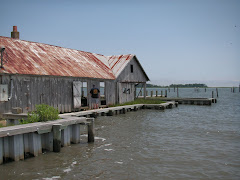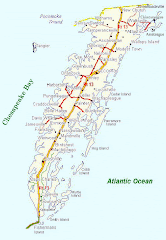Way back in the mid-1760’s, two
men – Charles Mason and Jeremiah Dixon – surveyed land south of Philadelphia , Pennsylvania
Those new lines helped define West Virginia , Maryland ,
Pennsylvania , and Delaware ,
and became known as the Mason-Dixon Line .
I’m not sure if you’re aware, but
this marked the location where any politician who lived in Maryland Delaware
My sainted wife and I often
travel up and down the Eastern Seaboard, usually Interstate 95. Even on secondary roads and byways, travelers
are greeted with signs proudly offering peaches and fresh local corn.
Once, I obediently followed the
312 signs made from elderly plywood to find a ramshackle road stand selling
over-priced peaches to unsuspecting Canadians for $12 a half-dozen.
At that price, someone had better
be chewing it for me. But I digress,
again.
But it wasn’t until this last
trip south that I noticed something that had been hiding in plain sight. Several main arteries on The Eastern Shore have
folks with rusty pickup trucks with those aluminum turkey deep-fryers, with
propane burners, in the beds. Adjacent
to them are hand-written signs – in poor penmanship, I might add – noting they
are selling “boiled peanuts.”
I’ve passed these yokels for
years without so much as an inkling as to what a boiled peanut was. This year, though, was different.
My sainted wife was born and
reared in The South – below the Mason-Dixon Line .
People in The South are a funny
bunch. They have their own language own
and their own food system.
The South’s official language is
“Fah-zhoo.” Most Southerners say,
“Fahzhoo, I wouldn’t make fun of the way we talk.”
Education-wise, Southerners are
gleeful when they tell you they dropped out of elementary school when they were
only 19-years old.
And their food system consists of
staples found nowhere else. Vittles such
as grits, that taste like buttered sand; greens that closely resemble, and
taste like, lawn weeds; and their all-too-famous boiled peanuts.
It was about time to find out
what boiled peanuts tasted like, if only to allow me to give the rest of America
Our exit from I-95 led my sainted
wife and Smokey and me down a dirt road peppered with cardboard arrows pointing
toward “delicious boiled peanuts.”
The drive wasn’t too far when we
came across a typical boiled peanut vendor and his I pickup truck.
 |
| Yummy boiled peanuts. Sure. |
I exited our vehicle and asked this
toothless entrepreneur “how much?”
His five-day shadow changed shape
when he grinned and said, “Tree dol…”
This South Carolina
Not knowing the going rate for
boiled peanuts, I agreed to his price.
He pulled out a large Styrofoam coffee cup and ladled some brown liquid,
along with some turd-like lumps into this vessel. Money exchanged hands.
I got back into our vehicle and
my sainted wife began shaking her head in her special I-can’t-believe-you-just-did-that
look.
The last time I saw that cluster
of facial expression and head movement, I had just invested in a guaranteed
generous cash-return earthworm farm. But
that’s another story for another time.
Smokey was poking his nose
through his travel cage in the back seat, anxious to figure out what that
foreign smell was.
We reached our destination and I
opened the cup lid. My mind began taking
many twists and turns about what this concoction looked and smelled like.
I wasn’t sure whether the shells
should be consumed or discarded. What
about the red skins on the peanuts themselves?
I am an Olympic-class salted-in-the-shell peanut eater. This, however, was something new altogether.
After some contemplation, I
drained the peanut juice and replaced the lid before it when into the trash
can.
Oh, those wacky Southerners know
how to live.




